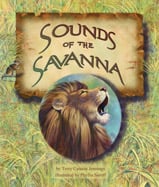Alignment to Standards for KY

| Grade | Number | Standard |
|---|---|---|
| 4 | SC-04-1.2.3a | explain that sound is a result of vibrations, a type of motion; |
| 4 | SC-04-1.2.3b | describe pitch (high, low) as a difference in sounds that are produced and relate that to the rate of vibration. Vibration is a type of motion that can be observed, described, measured and compared. Sound is produced by vibrating objects. The pitch of the |
| 4 | SC-04-3.4.1b | make inferences about the relationship between structure and function in organisms. Each plant or animal has structures that serve different functions in growth, survival and reproduction. For example, humans have distinct body structures for walking |
| 4 | SC-04-4.7.1a | patterns of evidence related to the survival and reproductive success of organisms in particular environments. |
| 4 | SC-4-MF-S-3 | rate of vibration of an object changes the pitch (high-low) of the sound it produces |
| 4 | SC-4-MF-U-3 | Students will understand that sound is produced by the vibration of matter, and the rate of vibration affects the pitch of the sound. |
| 4 | SC-4-UD-S-5 | questions about the diversity of living things using information from a variety of print and non-print sources |
| 4 | SC-4-UD-U-3 | organisms have different structures that are used for different functions. Observations of the structures of a certain organism can be used to predict how that organism functions or where it might live. |
| 5 | SC-5-I-U-2 | populations interact with each other in an ecosystem form a specific community, but there may be multiple communities within the same ecosystem. |
| Primary | SC-EP-3.4.1 | Organisms have basic needs. For example, animals need air, water and food; plants need air, water, nutrients and light. Organisms can survive only in environments in which their needs can be met. |
| Primary | SC-EP-3.4.3 | Students will describe the basic structures and related functions of plants and animals that contribute to growth, reproduction and survival. |
| Primary | SC-EP-3.4.3a | Each plant or animal has observable structures that serve different functions in growth, survival and reproduction. For example, humans have distinct body structures for walking, holding, seeing and talking. These observable structures should be explored |
| Primary | SC-P-MF-S-5 | differences in sounds (high and low pitch) produced by vibrations (e.g., making musical instruments that have moving parts that vibrate to produce sound) |
| Primary | SC-P-UD-S-1 | Students will describe the basic needs of organisms and explain how these survival needs can be met only in certain environments |
| Primary | SC-P-UD-S-3 | Students will investigate adaptations that enable animals and plants to grow, reproduce and survive (e.g., movements, body coverings, method of reproduction) |
| Primary | SC-P-UD-S-4 | Students will analyze structures of plants and animals to make inferences about the types of environments for which they are suited |
| Primary | SC-P-UD-U-3 | some animals are alike in the way they look and in the things they do, and others are very different from one another. |